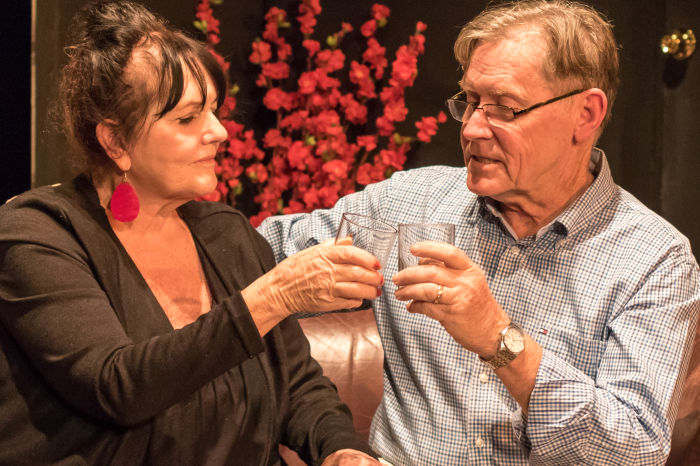Jim and Eva Rogers (Ross Scott and Sylvia White) have had a happy marriage. Having met first at amateur theatre playing the roles of the tragic young lovers, Romeo and Juliet, their long years of a happy, fulfilling relationship gives the lie to a general perception that passionate love is transient. They are well matched in terms of temperament, and Eva manages her husband’s occasional irascibility and he indulges her tendency to over-dramatise. It is apparent there is still a potent chemistry between them, although Jim is profoundly demoralised by the loss of his virility, a subject discussed with Dr Russell (David Luke) both candidly and humorously.
However, there are deeper tensions. There has been long-term conflict between Jim and daughter, Julia, which, reading between the lines, has led to Julia’s inability to settle in life. Her eventual decision to attempt a geographic escape to England taking her daughter, Rosie, with her has deprived Jim and Eva of a relationship with their granddaughter. When Julia contacts Eva seven months after her return to Australia telling her that Rosie has run away, Eva collapses. Consequent medical treatment leads to the discovery, which we learn through Dr Russell’s forthright but kindly talk with Jim, that Eva has a brain tumour and three months to live at the most.
This devastating news is slightly mitigated by the arrival of 19-year-old Rosie, who, as she puts it “has run away to them”. At this sad point in their life Rosie’s love for her grandparents becomes a guiding star. When the doctor’s lover, Nurse Stacey (Sarah Plummer), reveals to the Rogers she has helped Eva’s friend, the widowed, ill and unhappy Jessie (Denise Kitching), to find a release from an insupportable life, the Rogers see a way of bringing their lives and love “that has no end” to a fitting close.
The loving Rosie supports their decision, understanding their need for control over the terms of their own life. As she sprinkles their ashes onto a garden, it is clear the freedom to choose death as an alternative to pain, deterioration and dreadful loneliness should be at least a possibility, if it is rationally desired. At present, the prospect of facing deep and it seems perhaps senseless suffering places doctors, like Dr Russell, in an agonising dilemma.
The performances were sincerely felt and staged in a simple but effective way (light and sound, Kodie Amos) allowing for changes of location on the one plane. However the dialogue, which at times relied too much on speechifying and at other times was repetitive and unconvincing, needs refining if the play is to have a greater impact. In addition, recurring motifs, for instance, the humming of the song “The Riddle” and the phrase “a broken heart”, could be treated less insistently. Nevertheless, Is It Time is an honest production exploring some difficult issues.






